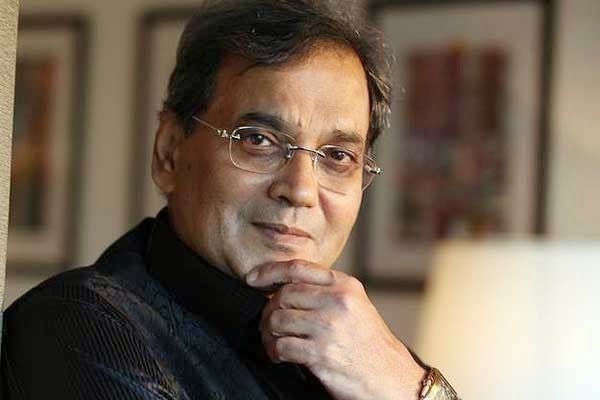“We are making constructive efforts to finally turn Mukta Arts into an institution”
– SUBHASH GHAI
How did the idea of setting up Audeus germinate in your mind?
– When I set up Mukta Arts in 1982, I wanted to model it along the lines of the big studios of yesteryears. V. Shantaram’s Rajkamal, Bombay Talkies and others were all institutions in themselves. Similarly, we do not want Mukta Arts to remain just a film production house, but we are making constructive efforts to finally turn it into an institution. Launching new talents, having a large number of technicians on payroll are only a few of our efforts to make Mukta Arts function like the studios of olden days. But, we do not want to stop at just that.
The biggest loss the industry suffered with the closing of the studio culture, was in the area of research & development. The studios could afford to invest in innovative technical experiments because of their institutional status. This is not possible for today’s independent film producers. So, promotion of R & D became another important purpose behind the setting up of Audeus.
Apart from that, as a filmmaker, I have always dreamt of having a state-of-the-art studio of my own. I have been able to fulfill this dream with Audeus.
What makes you confident of good returns on a huge investment such as this?
– The level of technical awareness has improved vastly not only among filmmakers but also among the viewers. The public is not going to accept technically inferior films today. Thus if a film producer wants to fight the satellite invasion, he will have to come to studios like Audeus and make his film with the help of the latest equipments.
How long did it take to complete the studio?
– We had already bought the plot after Khal-Nayak in 1993, but then Trimurti flopped and our company faced a few financial difficulties as a result. Finally, we began working constructively on this studio about three years back and were able to complete it in May this year.
How did you decide on the name ‘Audeus’?
– Someone had once told me that Audeus means ‘harmonious sound’ in Greek. I liked its sound and because it conveys the idea behind the studio, I chose to name it thus.
All equipments are becoming outdated in a short span of time as newer and better equipments are developed every now and then. This means that there is a need for constant upgradation of equipments in studios such as Audeus. How will you tackle this problem?
– You are right. Existing technology becomes outdated every six months. We are aware of this fact and hence we have a set plan to upgrade the equipment at Audeus at regular intervals.
We also have a plan to add to the present set-up which constitutes only the 1st phase of the project. We have acquired a total area of 13,000 sq. ft., out of which Audeus takes up only 6,000 sq. ft. We still have an unutilised area of 7,000 sq. ft. on which we will introduce state-of-the-art song recording rooms and mixing halls in phases II and III of the project. We intend to turn Audeus into a one-stop post-production shop for feature films within a year.
Are there any plans of setting up similar studios in the future?
– Not similar, but larger and even more beneficial to the film industry. I want to set up a large state-of-the-art shooting floor fully equipped with the latest lighting equipment and other modern facilities. I also plan to set up an institute where young talents and aspiring technicians will be trained in the latest techniques. Moreover, I have plans to establish a library of film-related reading material like screenplays, etc. It is impossible to lay one’s hands on script or screenplay of any film, especially for one not connected with films. I would like to have these in a library open to any person interested in films, whether rich or poor. Again, these efforts will directly contribute towards turning Mukta Arts into an institution, as I mentioned before.
Any parting words?
– I would like to give back to the industry whatever I have earned from it and I hope that my efforts will serve the industry well.
LATEST POSITION
The box-office continues to present a gloomy picture as far as new releases are concerned.
Dushman faced a steep decline mid-week. 1st week Bombay 40,07,228 (70.19%) from 14 cinemas (6 on F.H.); Ahmedabad 5,59,385 from 6 cinemas, Jamnagar (matinee) 17,780; Pune 8,27,633 from 6 cinemas, Solapur 1,07,615 (1 unrecd.); Hubli 1,06,827, Belgaum 53,887; Delhi 20,39,291 (54.56%) from 8 cinemas (1 unrecd., 1 on F.H.); Kanpur 1,65,219, Lucknow 1,77,898, Agra 1,40,897, Varanasi 1,17,252; Calcutta 12,54,829 from 11 cinemas; Nagpur 1,55,681 from 2 cinemas, Akola 68,082, Raipur (6 days) 1,08,995, Yavatmal 1,05,246 (2nd week 1st day 8,282); Bhopal 2,34,550 from 2 cinemas; Jaipur 4,88,165 from 3 cinemas; Hyderabad 15,44,734 from 8 cinemas.
………..
Jab Pyaar Kisise Hota Hai is steady in Bombay (good cinemas), Delhi city (good cinemas), C.I. and very good in Rajasthan but drops further in U.P., East Punjab, Bengal, Bihar, C.P. and Nizam. 2nd week Bombay 28,27,275 (76.24%) from 7 cinemas (6 on F.H.); Ahmedabad 73,948, Jamnagar 70,761; Pune 6,49,894 from 3 cinemas (1 in matinee), Solapur 91,340; Hubli 1,63,614, Belgaum 1,07,536; Delhi 26,80,178 from 7 cinemas (1 on F.H.); Kanpur 1,79,352 from 2 cinemas, Lucknow 2,10,375, Allahabad 69,450, Bareilly (6 days) 81,033 (42%), total 2,22,467; Calcutta 7,78,803 from 7 cinemas; Nagpur 1,99,740, Jabalpur (6 days) 1,11,847, Akola 68,879, 1st week Raipur 1,30,583 (53.92%), Bhilai 1,01,225, Durg 90,543, 2nd week Jalgaon (6 days) 65,689, Chandrapur 1,12,761, total 2,86,565, 1st Bilaspur 1,56,190; 2nd Bhopal (6 days) 1,72,604 from 2 cinemas; Jaipur 2,58,186; Hyderabad 5,43,725 from 3 cinemas.
Mard 2nd week Bombay 96,171 (27.18%); Ahmedabad 84,725 from 2 cinemas, Baroda 47,353; Pune 77,940 from 2 cinemas (1 in matinee), 1st week Solapur 32,937; 2nd week Delhi 4,89,615 from 4 cinemas (1 on F.H.); Kanpur 28,459, Lucknow 45,853, Allahabad 32,500, Varanasi 57,571, Bareilly 47,714 (22.09%), 1st week Hardwar 44,827; Rohtak 7,575; 2nd week Calcutta 96,482; Nagpur 47,918, 1st week Jabalpur (6 days) 66,875, 2nd week Amravati 66,499, 1st Akola 90,746, 2nd week Raipur 62,515, 1st Bhilai 32,392, 2nd Bilaspur (6 days) 45,567, total 1,26,072; Bhopal 30,610; Jodhpur 79,000, 1st week Bikaner 1,69,296.
………..
Chhota Chetan (partly dubbed, revived, 3D) 7th week Bombay (TF) 19,27,044 (90.38%) from 3 cinemas (3 on F.H.); Ahmedabad 1,21,755; Pune (TF) 3,13,253, 5th week Solapur (TF) 55,678; 7th week Delhi (TF) 11,94,960 from 3 cinemas; Agra 27,635, 1st week Allahabad 88,020; Nagpur (TF) 3,26,234, 2nd week Amravati (TF) 1,48,737, 1st Chandrapur (TF, 27 shows) 1,23,835 (2nd week 1st day 16,225); 3rd week Hyderabad 3,05,801.
BOMBAY HC STAYS FURTHER DEALING IN ‘LAL BAADSHAH’ AUDIO RIGHTS
K.C. Bokadia’s Lal Baadshah has run into rough weather. The Bombay high court, by an order passed on 27th May, has prohibited further dealing in the film’s audio rights. This order was passed by the court in a motion filed by Vijay Chokhani of Pearl Video Films.
K.C. Bokadia had borrowed a sum of Rs. 10 lakh from Vijay Chokhani of Pearl Video Films, while agreeing to hand over the audio rights of Lal Baadshah as security against the loan. Later, K.C. Bokadia sold the audio rights of the film to Pen Audio in violation of the agreement with Vijay Chokhani. As a result, Pearl Video Films filed a suit in the Bombay high court, which, in an order passed on 29th April, asked Pen Audio to deposit a sum of Rs. 5 lakh with the court within 4 weeks.
Pen Audio filed an application for extension of time, which was rejected by the court on 27th May.
The court’s order prohibiting further dealing in the film’s audio rights, therefore, stands in view of the fact that Pen Audio failed to deposit the money with the court.
ARUDRA PASSES AWAY
Renowned Telugu film writer and poet Bhagavathula Shankara Sastry, popularly known as Arudra, passed away on 4th June in Madras after a brief illness. Apart from his outstanding work as a writer, poet, literary critic and historian, Arudra penned lyrics for over 2,000 Telugu film songs and also wrote dialogues for nearly 150 Telugu films. He was also the recipient of the Sahitya Akademi awards of both, the Central as well as the Andhra Pradesh state governments.
He is survived by his writer-wife, K. Ramalaxmi, and three daughters.
SUBHASH GHAI’S AUDEUS LAUNCHED
Dilip Kumar formally inaugurated Subhash Ghai’s state-of-the-art post-production and shooting studio, Audeus, on 31st May. Shabana Azmi lit the traditional lamp, and Bharat Shah cracked the auspicious coconut. A large number of industry people graced the launching of the studio situated off Link Road, Andheri, Bombay.
Audeus has a Fairlight MFX 3 Plus Digital Audio Workstation inclusive of a dubbing suite, an Avid Media Composer (with Film Option), a sound transfer room, a Steenbeck editing studio, an air-conditioned shooting floor (60 feet by 40 feet by 17 feet height) and a sound-proof generator.
The Workstation is widely used in Hollywood. The Avid Media Composer enables non-linear editing for television and film.
PRASAR BHARATI BILL MOVED
I & B minister Sushma Swaraj on June 1 moved the Prasar Bharati Bill in Parliament. Some new clauses, other than those provided in the October ordinance, have been added. Under the new Bill, the term of office of part-time members will be six years. One-third of them will retire every two years. The whole-time member will retire at the age of 62 years and will not be entitled to any compensation because of his ceasing to hold such office. No part-time member will be entitled to any compensation. The President of India will appoint a president and ten board members. Four of them will be Parliament members. A recruitment board will be formed, comprising the chairman, other members, ex-officio members, the nominated member and elected members for posts equivalent to joint secretaries.
The day the Bill is passed, S.S. Gill will cease to be the chief executive officer, as his age is 70 years. He will not be entitled to any compensation.
Video Piracy And Overseas Distribution
Apropos the article on video piracy, carried in Film Information last week, some more disturbing facts have come to light — this time, in connection with Philippines, where scheduled releases of several Hindi films have had to be cancelled due to the arrival of pirated video copies of films prior to their theatrical screenings.
The Philippines distributor of Duplicate had to suffer heavy losses after the film was released there on 24th May. It is reported that the pirated video tapes of the film had already hit the market as early as on 17th May. Moreover, the prints of these pirated tapes were of a crystal-clear quality and contained no advertisements. As a result, the attendance in the cinema which screened the film did not even cross 50% of the expected occupancy. Later, the scheduled release of Jab Pyaar Kisise Hota Hai had to be cancelled by the distributor in an attempt to avoid losses as the pirated copies of the film had already surfaced in video stores a few days before its theatrical release. Now, it is learnt that the scheduled release of Dushman, too, has met with the same fate.
According to a leading distributor of Philippines, these pirated video tapes are of superb quality, and the video cassettes of two of the abovementioned three films had no advertisements in them. Incidentally, Pakistan still remains the source of origin of most pirated tapes of Hindi films, it is learnt.
This entire piracy operation is quickly gaining ground and unless urgent and firm steps are taken to exterminate it, some Overseas centres may become ‘dead’ for Hindi films forever.
No Substantial Relief For Industry In Union Budget
The Union Budget, announced on 1st June, has provided some relief to the film industry, but nothing substantial has been offered.
The amortisation period for films has been reduced from 180 days to 90 days. That is to say, the cost of films produced/released till 31st December (instead of 30th September earlier) will henceforth be allowed to be amortised. Rules 9A and 9B of the Income-Tax Rules provide for the entire cost of production/distribution of a film to be allowed in the financial year in which it is produced/released, only if the film is released before 1st October. In the case of a distributor, the cost of prints and publicity are allowed separately in the year in which it is incurred, whether the film is released before or after September 30. If a film is released after 30th September, the cost is allowed only to the extent of the revenue, the balance cost is amortised in the next financial year. The amortisation period has now been reduced to 90 days — that is, the cost of films released till 31st December will be fully allowed to be deducted.
Recorded video cassettes for television broadcast and audio cassettes have been exempted from the 8% excise duty.
Customs duty on cinema jumbo rolls has been reduced from 25% to 10%. The reduction in basic customs duty on positive film imported, from 25% to 10% is, however, not expected to have any impact on the final price because of various reasons: (a) an additional 8% value added tax has been levied and this is on the gross amount; (b) the MODVAT now available will be 95% instead of the earlier 100%; (c) the rupee has been further devalued in comparison to the dollar. Due to all the aforesaid reasons, the final price of positive raw stock will hardly undergo any change, according to Sushil Gupta and Bipin Salva, two leading dealers in the stock. Says Bipin Savla, “The 8% value added tax is not leviable on positive raw film as there is no indigenous production. If the tax is abolished, as being asked for by the industry, positive raw stock will become cheaper by Rs. 50 per roll, if not, it will become dearer by Rs. 50. The price of negative raw film will go up because while all other duties on its imports have remained the same, an additional 8% VAT has also been levied on it.”
The limit in section 258B of the Income-Tax Act has been increased from Rs. 5,000 to Rs. 25,000. Under the said section, producers will now be required to furnish information to the I-T department in respect of payments above Rs. 25,000 to any person now, instead of the earlier requirement of Rs. 5,000.
In the meantime, the AMPTPP has rushed ‘thank you’ telegrams to finance minister Yashwant Sinha, I & B minister Sushma Swaraj and MP Shatrughan Sinha for the reliefs in the Union Budget.
YOU ASKED IT
How many Hindi films are on the sets and how many more are complete and either being readied for release or already ready for release?
– About 250 films are at various stages of production. Of these, only about 100 films are making regular progress. About 225 films are complete and are either being readied for release or are already ready with their first copies out. Of these 225, at least 75 to 100 are lying unreleased and unsold since many years.
Will film prices come down now?
– They are already coming down, what with distributors often refusing to take deliveries at the contracted prices.
Why is Titanic not doing as well in centres where it is opening now, as it did eight and 10 weeks earlier?
– Firstly, because the TITANIC wave was at its peak 15 weeks back. Secondly, cable TV operators all over India have been telecasting TITANIC repeatedly and, therefore, the craze is definitely declining. A simultaneous release all over India would have been much better.
DO YOU KNOW?
* Although producer K.P. Singh launched HUM TO MOHABBAT KAREGA on 1st June, there was not a single shot that was canned that day. That’s because both, Bobby Deol and Karisma Kapoor, only rehearsed that entire day under the supervision of director Kundan Shah. Hum to rehearsal karega, what? Shooting started on 2nd.
* Qawwals are Rajiv Babbar’s favourites. Or so it would seem, going by the fact that he gave a filmi break to qawwal Altaf Raja in his SHAPATH, and is now giving a filmi break to another qawwal, Parveen Saba, in his new film, YAMRAAJ. Like he had a qawwali sung by Altaf, which was also picturised on the qawwal himself, Parveen Saba’s qawwali will also be picturised on Parveen herself.
* In 11 of the 17 centres in C.P. Berar, where the Rathi group controls cinemas, their cinemas have grossed the maximum entertainment tax/collections in the year ended 31st March, 1998. The cinemas which have topped the list in the various centres are: Smruti in Nagpur (51,40,016/- tax); Raj in Raipur (36,58,299/-); Shyam in Balaghat (gross collections 25,23,621/-); Vasant in Akola (23,09,153/- tax); Jyoti in Dhulia (17,38,316/-); Vasant in Wardha (12,66,880/-); Shyam in Yeotmal (12,25,328/-); Prabhat in Gondia (10,97,811/-); Shyam in Paratwada (5,64,086/-); Shree in Achalpur (3,73,479/-); and Jaihind in Badnera (3,13,984/-).
* PKTDK has created another U.P. record by collecting 1,53,175/- in 10th week at Novelty, Lucknow. Total for 10 weeks: 27,70,142/-.
* PKTDK has created another theatre record by collecting 60,697/- in 10th week at Uday, Akola. Total: 9,95,263/-. Share: 6,96,546/-.
* PKTDK has created a record by collecting 86,465/- in 1st week at Mayoor, Balaghat.
* CHHOTA CHETAN (tax-free) has created a city record by collecting 3,26,234/- (95%) in 1st week at Smruti, Nagpur, in spite of extreme heat and opposition of cricket matches.
* TITANIC has created a city record by collecting 6,65,816/- in 4 weeks at Amrut, Hubli. 4th week’s collection: 1,56,246/-.
COMMENTS
BHARAT SHAH
I’ve stopped financing films. I now either go in for world rights control or equal partnerships only.
TOLU BAJAJ
Film production is a tedious job and the returns in most of the cases are not commensurate with the amount of work put in. Given the efforts a producer puts in, he could earn much more in any other industry.
RAJ LALCHANDANI (Bombay distributor)
With films flopping one after another, somebody should organise a Satyanarayan pooja to appease the Gods.
RAJEEV MALHOTRA (Bombay exhibitor)
Looking at DCRs these days is a nightmarish experience.
NITIN GHELANI (Bombay exhibitor)
The position is such today that a distributor, who doesn’t release a film on Friday, is in profit. Because, not making a loss is akin to making a profit.
Are We Prepared For Industry Status?
Ever since the I & B minister announced industry status for films, it has become a fashion — or almost so — in the industry to express joy and contentment over the newly conferred ‘title’. Since the modalities have still to be worked out, one doesn’t really know what the new status will translate into in terms of day-to-day functioning of producers, artistes, exhibitors, distributors and all the others who are a part of the film industry. Not just that, most of the industry folk aren’t even aware of what implications the word ‘industry’ added after the word ‘film’ would have, whether it would bring in more advantages than headaches, whether it would make life any less miserable than it has become today for the industry folk.
Which brings us to the pertinent question: are we really prepared for the industry status? The immediate thing that comes to a producer’s mind when he talks of films as an industry is financing of film production by banks and financial institutions. But, contrary to general belief, mere industry status is not enough to prompt banks and other financial institutions to offer loans to producers on a platter. For this, producers too will have to support their loan applications with a lot of paper-work, facts and figures. A project report is one of the first things a bank will ask of a producer. Not many producers today are even aware of what a project report is or how it is to be prepared. Because of the disorganised way in which the industry has been functioning for years, there never had been left a need for something called a project report. But sooner than later, producers will start talking of project reports with banks and bank managers as they do dates diaries with stars and star-secretaries.
Making project reports will go a long way in bringing about organisation in the disorganised industry. For, projecting costs would require detailed planning and it would also guard against unnecessary and wasteful expenditure. Actually, project reports could also act as a handy tool in the hands of financiers and world rights controllers to keep a tab on where their finances are going, how much over-budget the film has gone, where costs need to be controlled, etc. etc. The utility of a project report to a financier apart, when monies are borrowed from banks and institutions instead of private financiers, a producer will simply not be able to do without a project report.
Insurance is another aspect that will need attention. There is an opinion that banks may insist on an insurance cover for the film they would finance. In that case, that would require more paper-work which, in turn, would also work towards bringing in discipline in the industry.
Are we ready for all this? If not, the industry had better gear up for reaping the fruits of industry status. The government has done its job of declaring showbiz as an industry. Let the opportunity now not slip out of the industry’s hands for lack of discipline and organisation. Let the industry show the government that it is ready for what it had asked. Let project reports, discipline, organisation, schedules and the like be the words of the new millennium. Let us bid goodbye to disorganisation, indiscipline, loose talks and the like.
– Komal Nahta
3-E
Education-Entertainment-Enlightenment
Too Many Releases In Too Few Weeks
The release schedules of the coming few weeks seem to be choc-a-bloc with too many films due for release within too short a time-span. Gharwali Baharwali, Achanak and Humse Badhkar Kaun are due next week. Ghulam releases a week after that, on 19th June; Major Saab is scheduled for 25th; and Satya and Kareeb, for 3rd July. This, at a time when Pyaar Kiya To Darna Kya, Jab Pyaar Kisise Hota Hai, Duplicate and Dushman are already showing in most ‘A’ class centres! Given the fact that at least two of the four running films will continue occupying cinema halls in the coming weeks, one wonders how the distributors for the abovementioned due-for-release films will find cinema halls to screen them, especially from and after 19th June. If one adds Chhota Chetan and Titanic to the list of films already occupying cinema halls, the scenario becomes even more frightening. And to think of it, just some weeks back, exhibitors did not have films to screen.
Films Go Abegging For Buyers
It had to happen. And it is happening. Distributors, reeling under the pressure of losses, are withdrawing from the scene. Many of the distributors of various circuits are simply not interested in buying films. “We are not in the race”, “We’d rather wait and watch”, “We don’t mind releasing films on commission basis, but buying them is out”, these and various similar comments are often being heard these days. Even ‘A’ grade set-ups are going abegging for buyers. Some of the top (in terms of makers, cast, music etc.) films are being offered to distributors for running on pure commission basis as they (distributors) are not prepared to pay MG royalties. Six months back, nobody would have imagined that this would be the state of affairs. But those who had the foresight, predicted, the situation would be terrible. Their prophecy is coming true.
Jitters Of A Different Kind
With three star-cast films — Gharwali Baharwali, Achanak and Humse Badhkar Kaun — set for release simultaneously next week, there is a lot of tension in the air. While the producers and distributors of these three films are understandably nervous as each of these films may bite into the other two’s collections, Manmohan Shetty of Adlabs is getting the jitters, but of a different kind. All the three films are being processed at Adlabs. Delivering such a large number of prints (almost 500 for the three films) by the same deadline must pose a massive problem. But knowing Manmohan Shetty’s planning and punctuality, one is sure, he will deliver every print before the deadline and, in the process, also add a few more feathers to the cap of Adlabs.
Too Much Is Too Bad
Mithun Chakraborty’s reckless signing has started taking its toll on producers and distributors of his starrers. With the last four Mithun-starrers — Ustadon Ke Ustad, Gudia (partially released), Hitler and Mard — bombing at the box-office, it is Mahendra Dhariwal, the producer of this week’s release, the Mithun-starrer Hatyara, who has had to bear the brunt. His distributors for Overseas and East Punjab took deliveries at reduced prices. The C.I. distributor had, a few days back, pleaded inability to take delivery and Dhariwal had, therefore, to change his distributor. The new price he got for C.I. was, of course, lesser than the earlier price. All of which have left the producer in deficit. Mithun Chakraborty and his prospective producers had better read the writing on the wall and go easy.
No Buyers
That sub-distributors for Gujarat and Saurashtra are shying away from coming forward to buy films is evident from the fact that Achanak has not been acquired by any party for these two sub-territories of Bombay circuit. This, despite starring Govinda and Manisha Koirala! On his part, Bombay distributor Dilip Dhanwani is not one bit perturbed by this. He is happy releasing the film all over the circuit himself, including in Thane district. Achanak is just one example. There are so many more films available for Gujarat, Saurashtra and Thane district but with no buyers in sight.
Marketing As Important As Making Film
The eagerly awaited Godzilla was premiered in Madison Square Gardens, New York, on 18th May. The film had one of the largest premieres ever in the history of Hollywood. Produced by Dean Devlin and directed by Roland Emmerich, Godzilla is the nineties’ version of the cult character created by Toho Co. of Japan in 1954 and featured in 22 American films since 1956. The film, released successfully in Asia on 25th May, has already recorded the biggest ever opening figures in Indonesia.
For both, Devlin and Emmerich, the duo who earlier gave Independence Day, making films has been an educating process in how to successfully market their films. This is the reason why they chalked out a previously unheard of promotional strategy for Godzilla — that of creating an aura of secrecy around the film’s post-production and not releasing any stills or trailer footage before the film’s release. The idea behind this was to increase speculation about Godzilla’s look and build up tension before the release of the film. According to Devlin, it had been a tremendous problem having to redefine Godzilla’s look as the character had already featured in so many films over the years. But they turned this very problem into a clever new marketing and promotional strategy which worked at keeping the brand new look of Godzilla a secret till the film’s release.
CBFC In The Dark
On 5th June, as the CBFC staff was preparing the censor certificate for Achanak, all the lights in the building went off due to a power failure and left everybody in the dark quite achanak. It is commendable that the CBFC staff managed to complete all the formalities and prepared the certificate by 2 p.m. in spite of inadequate light and oppressive heat. While producer Vijay Galani and director Naresh Malhotra must have shed their mehenat ka paseena during the making of Achanak, the CBFC staff literally sweated it out while making a censor certificate! Incidentally, the film was seen by the censors on 4th June and it was ordered some cuts. It is to the CBFC’s credit that the producer had the censor certificate in his hands within 24 hours of the film being viewed by the examining committee.





























